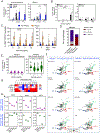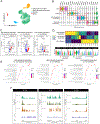Elucidating allergic reaction mechanisms in response to SARS-CoV-2 mRNA vaccination in adults
- PMID: 39033312
- PMCID: PMC11368657
- DOI: 10.1111/all.16231
Elucidating allergic reaction mechanisms in response to SARS-CoV-2 mRNA vaccination in adults
Erratum in
-
Corrigendum to "Elucidating Allergic Reaction Mechanisms in Response to SARS-CoV-2 mRNA Vaccination in Adults".Allergy. 2025 Mar;80(3):911. doi: 10.1111/all.16415. Epub 2024 Dec 7. Allergy. 2025. PMID: 39644176 No abstract available.
Abstract
Background: During the COVID-19 pandemic, novel nanoparticle-based mRNA vaccines were developed. A small number of individuals developed allergic reactions to these vaccines although the mechanisms remain undefined.
Methods: To understand COVID-19 vaccine-mediated allergic reactions, we enrolled 19 participants who developed allergic events within 2 h of vaccination and 13 controls, nonreactors. Using standard hemolysis assays, we demonstrated that sera from allergic participants induced stronger complement activation compared to nonallergic subjects following ex vivo vaccine exposure.
Results: Vaccine-mediated complement activation correlated with anti-polyethelyne glycol (PEG) IgG (but not IgM) levels while anti-PEG IgE was undetectable in all subjects. Depletion of total IgG suppressed complement activation in select individuals. To investigate the effects of vaccine excipients on basophil function, we employed a validated indirect basophil activation test that stratified the allergic populations into high and low responders. Complement C3a and C5a receptor blockade in this system suppressed basophil response, providing strong evidence for complement involvement in vaccine-mediated basophil activation. Single-cell multiome analysis revealed differential expression of genes encoding the cytokine response and Toll-like receptor (TLR) pathways within the monocyte compartment. Differential chromatin accessibility for IL-13 and IL-1B genes was found in allergic and nonallergic participants, suggesting that in vivo, epigenetic modulation of mononuclear phagocyte immunophenotypes determines their subsequent functional responsiveness, contributing to the overall physiologic manifestation of vaccine reactions.
Conclusion: These findings provide insights into the mechanisms underlying allergic reactions to COVID-19 mRNA vaccines, which may be used for future vaccine strategies in individuals with prior history of allergies or reactions and reduce vaccine hesitancy.
Keywords: COVID‐19; COVID‐19 vaccines; SARS‐CoV‐2; mRNA vaccines; polyethylene glycol; vaccine allergy.
© 2024 European Academy of Allergy and Clinical Immunology and John Wiley & Sons Ltd.
Conflict of interest statement
Competing Interests:
All authors declare no competing financial interests.
Figures







References
-
- Allergic Reactions Including Anaphylaxis After Receipt of the First Dose of Pfizer-BioNTech COVID-19 Vaccine — United States, December 14–23, 2020. Centers for Disease Control and Prevention (2021). Available at: https://www.cdc.gov/mmwr/volumes/70/wr/mm7002e1.htm. (Accessed: 1st September 2021)
-
- Allergic Reactions Including Anaphylaxis After Receipt of the First Dose of Moderna COVID-19 Vaccine — United States, December 21, 2020–January 10, 2021. Centers for Disease Control and Prevention (2021). Available at: https://www.cdc.gov/mmwr/volumes/70/wr/mm7004e1.htm. (Accessed: 1st September 2021).
MeSH terms
Substances
Grants and funding
LinkOut - more resources
Full Text Sources
Medical
Miscellaneous

